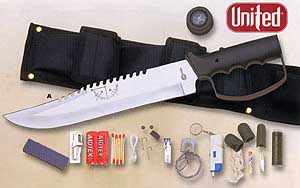Featured Member Video
How to stabilize scales, the easy way.More Videos by Camp10
View larger or ask the author a question.
View all wilderness survival videos
Recent Forum Posts 
| Thread Title | Replies |
| Auto detailing near me | 2 |
| commercial manager salary uk | 2 |
| проститутки кантем... | 0 |
| SAD that this forum........DIED. | 8 |
| best | 0 |
| .......... | 2 |
| weather | 0 |
| AR Pistol Notice | 18 |
| What "ONE" Thing do you h... | 0 |
| "WAREAGLE" Wherefore art-... | 0 |
Come Join the Discussion Today!
Our site has been mentioned in:
U.S. News and World Report
Best of the Web - Site of the Week 8/6/01
Discovery Channel Canada
One Week in the Wilderness
USA Today
Hot Sites 08/08/2005
Vacuum Packing Food for Long Term Storage
Vacuum packing at home is becoming a popular way to store food, both for the short-term and the long-term. All it means is that you have removed nearly all of the air from a package, leaving it inhospitable for bacteria, mold, and mildew. This is usually done with food packaged in sealable plastic bags though you can utilize vacuum-packing techniques with food in glass jars as well. The air is removed with an electric pump, though you can get a good vacuum with a manual one if you prefer.
Pros and Cons of Vacuum Packing
It's a fairly simple process that doesn't require very much time or effort to utilize. Use your pump system to remove the air, seal the container and store it. The lack of air helps keep food fresh longer.
Whether or not you can use regular sealable bags (like ziplock brand) will depend on the type of vacuum unit you are using. Pump units will often work on these bags, but those that are built to seal as well as pump only operate with their own brand of plastic. This can be a big of a negative as the rolls can be expensive compared to standard plastic bags, which are cheaper and reusable.
One positive aspect that comes specifically with vacuum packing in plastic bags is that your packages will take up less space with all the air removed. This is ideal when storage space is limited. Using a vacuum sealing with glass jars won't give you this benefit though. These bags can then be stored on the shelf, like home-canned food. You can also use vacuum-packing for freezer goods to help reduce freezer burn and extend storage time again.
Once all of the air has been sucked out of a bag, it will conform very tightly to the shape of whatever is inside. For large items, this is mostly irrelevant but if you are vacuum-packing loose items such as rice or dry pasta, it will create a very hard package as the pieces are drawn together within the plastic. This will make your food far more durable than leaving it in a standard air-filled bag.
Basic Packing Methods
How you vacuum pack will mainly depend on the type of machine or device you are using. Smaller hand-pump units such as the Pump and Seal work like an old-fashioned air tire pump. You insert one end into a standard zip-lock style bag, and work the pump to get all of the air out. Seal up the bag quickly, and that's all there is to it.
You can use these types of pumps with Mason or canning jars as well. You usually have to prick a hole in the lid so that the pump can draw out the air (most pumps have an adaptor for this so you only need a very small hole). Then you use heavy duty tape or provided adhesive seals to cover the hole and maintain the vacuum inside.
If you are using a pump unit that also seals the bags, such as a Tilia, then the process is a little different. These machines have a heat-sealing portion that seals the plastic bag closed. Granted, they create a tighter seal than a ziplock bag but you will have to purchase the rolls of plastic that go with the machine. These basically a long tube of thin plastic that ends up being sealed at both ends to suit the size of whatever you are bagging up. The machine is electric and uses a pump to remove all the air and then heat seals the end. Though you have to purchase the rolls of plastic, they can be more practical because you can size your "bags" to suit whatever you are packing.
Some models of Tilia have a jar attachment to allow you to remove air from jars as well. Again, you will have to punch a hole in the lid that needs resealing when you are done.
If you are planning on storing dry goods in buckets, you can still take advantage of the air-removal principle of vacuum-packing though you won't be able to create a true vacuum. See the chapter on containers for ways to remove oxygen from buckets.
Ultimate Survival Knife & Kit |
List Price: 61.99 Our Price: 39.95 |
This 15 inch survival knife with drop point blade features a thick quality stainless steel blade with serrated top edge. Textured and ribbed solid metal handle and guard. Nylon sheath. Survival kit includes a hollow grip with a compass top to store items within the knife itself, as well as additional pouches on the sheath to hold the rest. Complete survival kit. Click Here to Buy the Survival Knife Now. |
|

